 Planets Planets
 Jupiter Jupiter
 General features General features
 The Atmosphere The Atmosphere
 The Great Red Spot The Great Red Spot
 The Interior The Interior
 The Magnetic Field The Magnetic Field
|
|
| |
The planet Jupiter |
| |
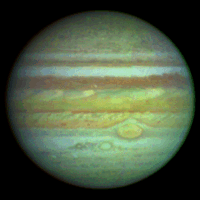 The planet Jupiter is shown in the adjacent Hubble Space Telescope
true-color image
(Ref).
Jupiter is by far the largest of the planets. It is more
than twice as massive as all other planets combined; if it had
been only about 100 times more massive at birth (not so much by astronomical
standards) it would have become a star instead of a planet. Then the Solar
System might be a double star system instead of a single star with a planetary system.
The planet Jupiter is shown in the adjacent Hubble Space Telescope
true-color image
(Ref).
Jupiter is by far the largest of the planets. It is more
than twice as massive as all other planets combined; if it had
been only about 100 times more massive at birth (not so much by astronomical
standards) it would have become a star instead of a planet. Then the Solar
System might be a double star system instead of a single star with a planetary system.
Jupiter has features very different from terrestrial planets. Its
composition is more like that of stars, and if it has any solid surface it is
hidden deep at its center: Jupiter is apparently almost entirely gas and
liquid. It also has an internal energy source and enormous magnetic fields.
Finally, the 4 largest moons of Jupiter (the Galilean Moons) are sufficiently
interesting in their own right that they are among the most studied objects in
the Solar System. We shall devote a separate section to studying their properties.
Our most detailed information concerning Jupiter has come from the space probes
Pioneer 10 (1973), Pioneer 11 (1974), Voyager I (March, 1979), Voyager
II (July, 1979), and Galileo (1995-present). The first 4 were flyby missions;
the Galileo probe was inserted into orbit around Jupiter December, 1995, and
launched a probe into the atmosphere that transmitted information before beingdestroyed. The
Galileo orbiter is in a complex orbit that has been examining Jupiter and the Galilean moons.
|
| |
General features |
| |
The planet Jupiter is 5.2 A.U. from the Sun on average, which corresponds to an
orbital period of 11.9 Earth years.
It is the most massive planet, being 318 times as massive as the Earth, and
about 2 1/2 times the mass of all other planets combined.
Jupiter is massive
because it has a large diameter (11.2 times that of Earth). Its density is
only 1.33 g/cc, which is 1/4 that of Earth, and only slightly more than
the 1 g/cc characteristic of water.
This very low density compared with the terrestrial planets is because it
is composed mostly of hydrogen and helium, in ratios similar to that found
in stars (approximately 82% hydrogen and 17% helium by mass).
Furthermore, Jupiter
is almost entirely gas and liquid. Therefore, Jupiter and the
related planets Saturn, Uranus, and Neptune are sometimes called Gas
Giants (these are also called the Jovian Planets, since Jove was
another name for Jupiter). We guess that Jupiter probably has a small rocky
core comparable in size to terrestrial planets and perhaps with a similar
composition, but we have no direct evidence of this.
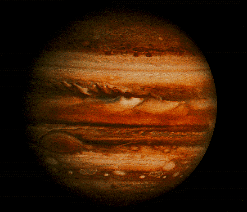 Because Jupiter is not solid its parts do not rotate at exactly the same
velocity. However, measurements of the rotation of the magnetic field give a
rotation period of 9 hours and 55 minutes. This rapid rotation and the gas and
liquid structure give rise to a pronounced equatorial bulge that is evident in
images such as the adjacent one.
Because Jupiter is not solid its parts do not rotate at exactly the same
velocity. However, measurements of the rotation of the magnetic field give a
rotation period of 9 hours and 55 minutes. This rapid rotation and the gas and
liquid structure give rise to a pronounced equatorial bulge that is evident in
images such as the adjacent one.
As also indicated in the adjacent computer-enhanced image
(Ref),
the atmosphere has clouds with a colorful and complex
structure. These features are partially associated with the effect of very
high velocity winds in the Jovian atmosphere (as much as 900 km/hr).
It also has an large, complex, and very intense magnetic field, and has a
system of 16 moons that is a kind of miniature Solar System unto itself. It
has an internal heat source, since it emits more radiation than it receives.
This is thought to be associated with residual heat left over from the
formation of the planet. Finally, it even has a faint ring.
|
| |
The Atmosphere |
| |
Jupiter has a very complex atmosphere. It is dominated by colorful bands and
turbulent swirls, as illustrated in the following two images.
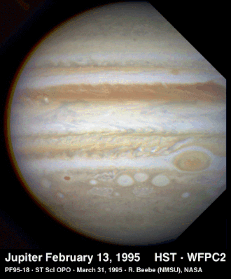 |
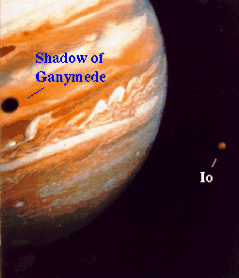 |
| Storms in the atmosphere of Jupiter
(Ref and
Explanation) |
Jupiter and Io with Ganymede's shadow on Jupiter
(Ref) |
Zones and Belts
All that we see is the top of the atmosphere. The light bands are called
zones and the darker bands are called belts. The zones tend
to be white or yellow, while the belts are often some shade of reddish brown.
Temperature measurements by the Pioneer spacecraft (1973) established that the
temperature of the dark belts is higher than that of the light zones, implying
that the former are lower in the atmosphere. Thus, the belts appear to be
regions of descending gas and the zones are regions of rising gas.
Each hemisphere has around 6 bands with winds blowing at very high velocities
in opposite directions. This accounts for the extensive shear and turbulence
at the boundaries between these regions (see the next section on the Great Red
Spot). Large lightning bolts and extensive aurora have been observed in the
Jovian atmosphere, as we will discuss further when we consider Jupiter's
magnetic field.
The Great Red Spot
The most prominent feature is the "Great Red Spot", which may be seen on the right of
the upper left image, just below the equator, and in the two images shown
below. As we shall discuss in the next section, it is a kind of large and persistent storm driven by Jupiter's
internal heat source.
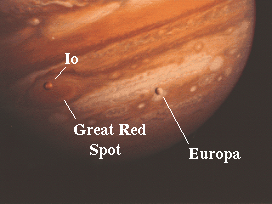 |
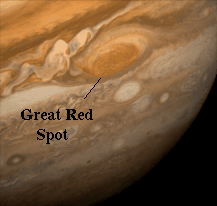 |
| Jupiter with two moons seen against its surface |
Jupiter's clouds near the Great Red Spot |
The Color of the Atmosphere
The explanation for the
color of Jupiter's
clouds is still something of a mystery. Although there are compounds in
Jupiter's atmosphere that could account for the colors if the atmosphere were
warmer, they should not be the
colors that are observed at the very cold temperatures in the tops of Jupiter's
clouds (about -150 degrees Celsius). It has been suggested that the colors
result either from colorful hydrogen compounds welling up from warmer regions,
or from colorful compounds associated with trace amounts of elements like sulfur in the
atmosphere. Consultation of past observations of Jupiter indicates that the clouds change their colors over time.
The Galileo Probe and Orbiter
The
Galileo Project is in the process of generating large amounts of new
information about Jupiter and its moons. The interpretation of the information
sent back by the probe that plunged into the atmosphere should yield valuable
insight, as will the extended observations from the Galileo orbiter.
Here is the present position and projected
orbit of Galileo.
|
| |
The Great Red Spot |
| |
The Great Red Spot
is a great anti-cyclonic (high pressure) storm akin to a
hurricane on Earth, but it is enormous (three Earths would fit within its
boundaries) and it has persisted for at least the 400 years that humans have
observed it through telescopes. Since it is anti-cyclonic in Jupiter's
Southern hemisphere, the rotation is counterclockwise, with a period of about 6
days. (A hurricane in Earth's
Southern hemisphere rotates clockwise because it is a low pressure system.)
The clouds associated with the Spot appear to be about 8 km above neighboringcloud tops.
The following two figures show a recent
Galileo view
of the Great Red Spot, and a closeup of the turbulence in its vicinity.
 |
 |
| A Galileo "true color" image of the Great Red Spot in 1996
(Ref) |
Turbulence near the Great Red Spot |
The Coriolis effects that are responsible for cyclones and anti-cyclones on
Earth are greatly magnified on Jupiter, which has a rotational frequency about
2 1/2 times that of Earth, but this alone would not account for the persistence
and size of the Great Red Spot. There are other features similar to the Great
Red Spot on the surface (note the white spots in the above images) but none are
as large as the Great Red Spot.
Presumably the persistence of the Great Red Spot is related to the fact that it
never comes over land, as in the case of a hurricane on Earth, and that it is
driven by Jupiter's internal heat source. Computer simulations suggest that
such large disturbances may be stable on Jupiter, and that stronger
disturbances tend to absorb weaker ones, which may explain the size of the
Great Red Spot. Furthermore, as for the clouds in general, we do not
understand fully the reason for the coloring. It has been suggested that
certain compounds of phosphorous are responsible for the reddish-brown hue, but this remains somewhat speculative.
Thus, we understand the broad properties, but not all the detailed features of this remarkable phenomenon.
|
| |
The Interior |
| |
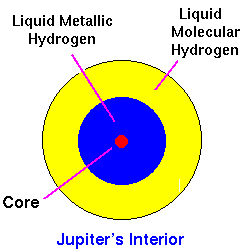 Most of the interior of Jupiter is liquid (primarily hydrogen and about 10%
helium). The central temperatures are thought to lie in the 13,000-35,000
degree Celsius range, and the central pressure is about 100 million Earth
atmospheres. We infer indirectly that the small core (perhaps a few tens of Earth masses) is rocky.
Most of the interior of Jupiter is liquid (primarily hydrogen and about 10%
helium). The central temperatures are thought to lie in the 13,000-35,000
degree Celsius range, and the central pressure is about 100 million Earth
atmospheres. We infer indirectly that the small core (perhaps a few tens of Earth masses) is rocky.
Liquid Metallic Hydrogen
The inner layers of highly compressed hydrogen are in a state that has never
been produced on the Earth. Normally, hydrogen does not conduct heat or
electricity very well, which are defining characteristics for a metal. Thus,
under normal conditions hydrogen is not a metal. Under the extreme pressure
found deep inside Jupiter, theory suggests that the electrons are released from
the hydrogen molecules and are free to move about the interior. This causes hydrogen to
behave as a metal: it becomes conducting for both heat and electricity.
The intense magnetic field of
Jupiter is thought to result from electrical currents in this region of
metallic hydrogen that is spinning rapidly and thought to
compose 75% of the planet's mass. We are limited in our understanding of
Jupiter's interior by the fact that we have no laboratory knowledge of the
behavior of hydrogen under such conditions and are forced to rely on theory.
Conversely, the properties of Jupiter provide a stringent test of our
understanding of matter under such extreme conditions.
Internal Source of Energy
Jupiter radiates 1.6 times a much energy as falls on it from the
Sun. Thus, Jupiter has an internal heat source. It is thought that much of this
heat is residual heat left over from the original collapse of the primordial
nebula to form the Solar System, but some may come from slow contraction
(liquids are highly incompressible, so Jupiter cannot be contracting very
much.) This internal heat source is presumably responsible for driving the
complex weather pattern in its atmosphere, unlike the Earth where the primary
heat source driving the weather is the Sun.
A Large Planet or a Failed Star?
Calculations suggest that Jupiter
lacks the mass to initiate hydrogen fusion reactions in its core and become a
star by about a factor of 100. Since factors of 100 are not so large on
astrophysical mass scales, it is legitimate at some level to
view Jupiter as either a very large planet, or a failed star.
|
| |
The Magnetic Field |
| |
Jupiter has a large, complex, and intense magnetic field that is thought to arise from
electrical currents in the rapidly spinning metallic hydrogen interior. The
Earth has a strong magnetic field, but Jupiter's magnetic field at the tops of
its clouds is 10 times stronger than that of the Earth. Further, the Jovian
magnetic field has much higher complexity than that of the Earth, with some
aspects of Jupiter's fields having no Earthly counterpart.
The intensity and complexity relative to the magnetic field of the Earth is presumably related in
some way to the more rapid rotation and larger metallic interior for Jupiter.
Features of the Magnetic Field
The following figure shows the field lines and some other features of Jupiter's magnetic field.
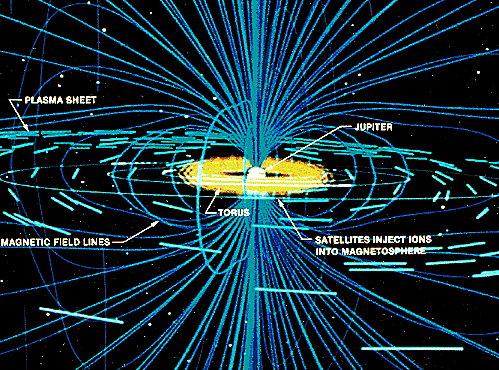 |
|
Jupiter's magnetic field
(Ref) |
The field is doughnut shaped (toroidal), containing giant versions of the Earth's
Van Allen Belts
that trap high-energy charged particles (mostly
electrons and protons). Because of the forces associated with the
rapid rotation of Jupiter and its magnetic field, these "belts" are flattened
into "plasma sheets" in the case of Jupiter.
The field rotates with the approximately 9 hour
rotational period of the planet.
The satellites Amalthea, Io, Europa, and Ganymede all
orbit through this region; they are affected by it and in turn affect the
magnetic field and charged-particle belts, as we discuss further below.
For example, the surface of Io is being eroded by collisions with these particles as it moves about its orbit.
The plasma torus indicated in the preceding figure is associated with
the orbit of Io. As we will see, Io has multiple active
volcanoes on its surface. These spew a gas of particles into
space that become ionized
as Io moves about its orbit, and these particles eventually diffuse into
the rest of the region surrounding Jupiter. As we discuss further below, this
is a major source of the charged particles trapped in the Jovian magnetic
field. Thus, Io is both responsible for many of the charged particles in
Jupiter's magnetic field, and is being eroded by collisions with those
particles as it orbits Jupiter.
Jupiter's Magnetosphere
The magnetosphere of Jupiter (the region of
space dominated by its magnetic field is enormous. It interacts with the solar
wind of charged particles from the Sun as far as 7 million kilometers from
Jupiter, forming a "bow shock" much like that produced by the bow of a ship in
water that deflects the charged particles of the solar wind. The following
figure illustrates.
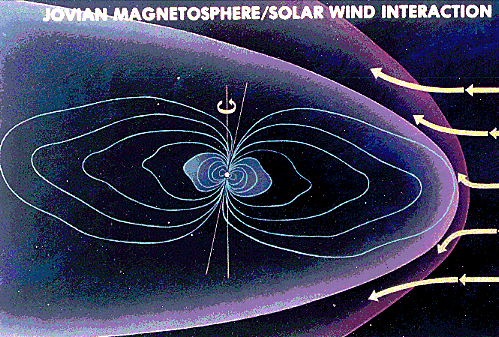 |
|
Jupiter's magnetosphere and interaction with the solar wind
(Ref) |
The magnetosphere is strongly affected by the solar wind, pulsing in shape and
size. It can shrink to 1/3 of its maximum size when the solar wind is strong.
Jupiter's Auroras
Intense auroras have been observed on Jupiter. The following figure shows
Hubble Space Telescope images of auroras near the Jovian poles.
On Earth, many of the charged particles trapped in our magnetic field originate
in the solar wind.
Since the bow shock of Jupiter's magnetosphere deflects the
solar wind well away from Jupiter's atmosphere,
the charged particles responsible for Jupiter's auroras must
come from another source. They are thought to originate from the innermost
satellites like Io that orbit in the region of strong magnetic field and
trapped charged particles.
|
|


